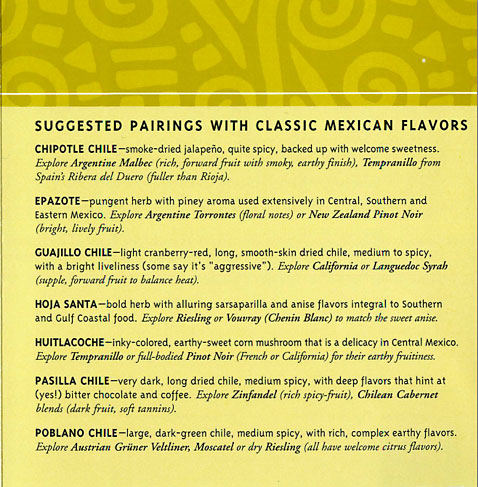7 steps for tipsheets
When the folks at Topolobampo, Chicago’s cathedral to Mexican cuisine, wanted to sell more syrah, they didn’t put signs on the tables saying “Buy wine!” Instead, they provided nifty little tabletop tipsheets on how to pair wine with Mexican food.

Take a tip from Topolobampo: Instead of always pushing your products, offer your customers news they can use to live their lives better. Tip sheets position your organization as the expert in the field and may drive more sales than purely promotional pieces.
Here are seven ways to make the most of your next tip sheet:
1. Find a topic.
Explain how to:
- Cut costs during the recession
- Save on taxes
- File for Social Security
- Grow a great lawn
- Reduce gas consumption
- Or do whatever it is your organization helps people do
Stumped? Check out this list of benefits. How can you help readers save money, save time, avoid effort and otherwise live their lives better?
The key here is to provide real value. Tip sheets on “Five reasons to work with Ann Wylie” will never gain traction. “10 tips for choosing an XYZ vendor” won’t change anyone’s life either.
Instead of offering self-serving tips, remember this content marketing formula: “Give, give, give, give, give, give, give, give, ask.”

2. Organize tips logically.
Choose the right structure:
- Alphabetical structure is best for glossaries, for instance.
- Chronological structure is the right choice for a series of steps. (As everyone who’s ever put together an Ikea bedside table well knows.)
- Hierarchical structure works best for top 10 lists.
3. Use the language of service stories.
How-to language — like top, 10, you, most, best and, of course, how to — has been a mainstay of service journalism for years. These days, this language tops the list of most-shared words and phrases on Facebook and Twitter, according to Zarrella’s research.
4. Put a number in the headline.
Numerals sell stories. That’s why coverlines on best-selling magazines are packed with numbers, from “Six Steps to Six-Pack Abs” to “101 Best Cheap Eats.” Blog post headlines and subject lines with numerals are more likely to get shared and opened, too.
But be careful: It’s not enough just to slap a 10 onto the headline. Odd numbers tend to outperform even numbers; specific numbers (99) are better than round ones (100); and 101 of anything is too many, unless you’re offering chocolate chip cookies or cute kitten videos.

5. Write in the imperative voice.
Speak directly to “you” using the second person, and start each item with a verb, like find, organize, use, put or write. That will also help you make your list of tips parallel, which your third-grade English teacher and I will appreciate.
6. Format your tips.
Numbered lists, bullets and bold-faced lead-ins lift your tips off the page and screen and make it easier for people to read your tips.
7. Deliver “go and do” information.
Links, phone numbers, times, dates, addresses and maps not only boost value. Links increase your message’s chances of going viral. And maps and addresses improve the chances that readers will act on your information.
Deliver news you can use.
“News you can use to live your life better” is the currency of most successful content marketing and PR writers.
Investor’s Business Daily’s motto is, “Don’t read it. Use it.” Shouldn’t that be your motto too?

Leave a Reply